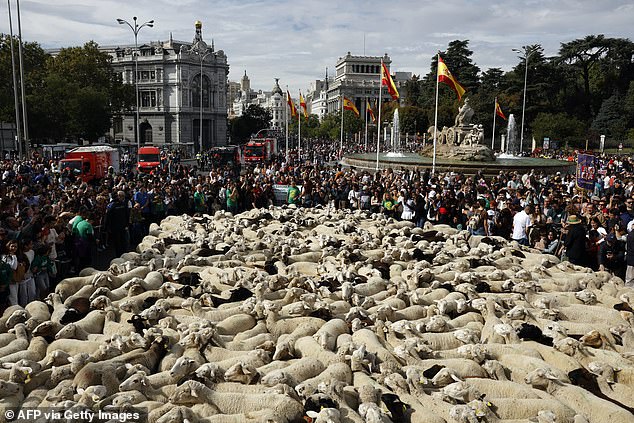It wasn’t traffic or tourists that brought Madrid’s streets to a standstill this weekend — it was sheep.
Thousands of locals and visitors watched in delight as 1,100 sheep and 200 goats made their way through the heart of Spain’s capital, filling the air with bells, bleats, and laughter.
The annual Transhumance Festival transformed the city into a scene straight out of a countryside fair, proving that even in the bustling heart of Madrid, rural traditions are very much alive.
A Celebration of Agriculture and Tradition
The Transhumance Festival, which began in 1994, pays tribute to Spain’s deep agricultural roots and celebrates the age-old practice of transhumance — the seasonal movement of livestock between pastures.
The event isn’t just about nostalgia; it’s about reminding city dwellers of the environmental importance of traditional grazing.
By moving animals through the countryside, herders help clear overgrown brush and flammable undergrowth, a natural way to reduce the risk of devastating wildfires.
It’s a centuries-old method that’s now being recognized as both culturally significant and environmentally smart.
Sheep Beside Skyscrapers
For a few magical hours, Madrid’s famous landmarks became the backdrop for an unexpected sight — flocks of woolly sheep and goats trotting past statues and cafés.
Locals and tourists lined the streets to take photos, cheer, and enjoy the unusual parade that blended country charm with city chaos.
“I think it’s wonderful,” said American tourist Jennifer Granda.
“It’s such an interesting concept — promoting agriculture right in the middle of the city. We really appreciated it.”
A 600-Year-Old Tradition
This festival may look like a bit of modern fun, but it’s actually rooted in history.
The Transhumance Festival traces its origins back to a medieval agreement from 1418 between Madrid’s city council and shepherds.
Every year, organisers pay a symbolic toll — 50 maravedis in ancient coins — to allow the animals to pass safely through the streets.
It’s a symbolic gesture that connects today’s farmers with generations of shepherds who once roamed the same routes across the Iberian Peninsula.
Madrid is part of a vast web of ancient migration trails that span Spain and Portugal, once used by herders moving their animals between summer and winter grazing grounds.
Environmentalists Sound the Alarm
While the event is filled with joy and tradition, it also carries a serious message.
Environmentalist Juan García Vicente, who has participated in the festival for three decades, warned that Spain’s rural world is under threat.
“We have to fight this on several fronts,” he said, referring to the growing impacts of climate change and the “total abandonment of the rural world.”
Vicente also pointed out that Spain recently endured one of the most destructive wildfire seasons in its history — a stark reminder of why maintaining traditional grazing is so important.
Keeping an Ancient Way of Life Alive
In a time when modern farming and urban expansion dominate, only a small number of farmers still practice transhumance.
These herders are not just maintaining an old custom; they’re preserving a sustainable way of living that benefits both the land and future generations.
Similar festivals celebrating pastoral migration are held in California, Italy, and France — all honoring the bond between people, animals, and the environment.
Locals Reflect on the Charm of the Festival
For many Madrileños, the Transhumance Festival is just one of the many beloved “fiestas” that bring color and warmth to their city.
Local resident Ana Vásquez, who caught the parade at Puerta del Sol with her husband, smiled as the last flock passed.
“It reminds us of another time,” she said. “It’s a nice tradition — one of those things that makes Spain special.”
A City Where Past and Present Walk Side by Side
As the sheep cleared the streets and the city returned to its usual rhythm, Madrid once again proved it can balance modern life with centuries-old customs.
The Transhumance Festival may only last a weekend, but its message endures — that honoring the past and protecting the planet can still go hand in hand, even in a city of millions.
Share on Facebook «||» Share on Twitter «||» Share on Reddit «||» Share on LinkedIn